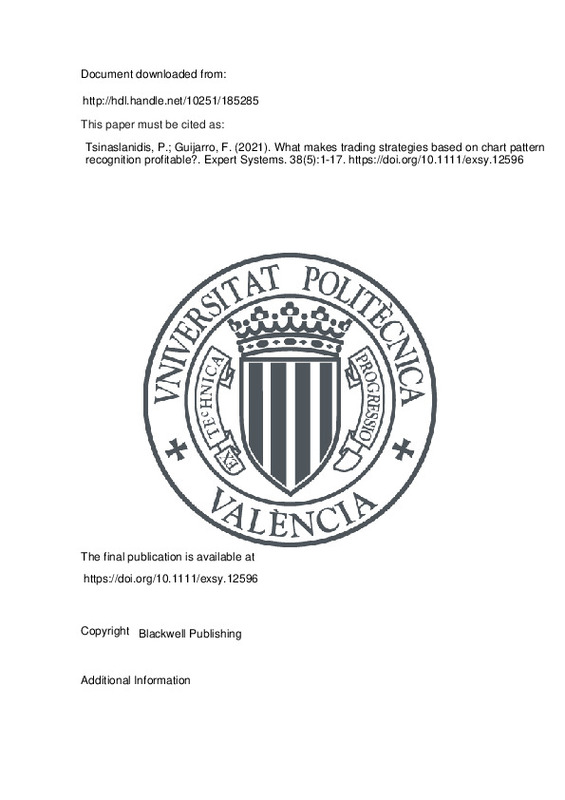JavaScript is disabled for your browser. Some features of this site may not work without it.
Buscar en RiuNet
Listar
Mi cuenta
Estadísticas
Ayuda RiuNet
Admin. UPV
What makes trading strategies based on chart pattern recognition profitable?
Mostrar el registro sencillo del ítem
Ficheros en el ítem
| dc.contributor.author | Tsinaslanidis, Prodromos
|
es_ES |
| dc.contributor.author | Guijarro, Francisco
|
es_ES |
| dc.date.accessioned | 2022-09-05T18:03:30Z | |
| dc.date.available | 2022-09-05T18:03:30Z | |
| dc.date.issued | 2021-08 | es_ES |
| dc.identifier.issn | 0266-4720 | es_ES |
| dc.identifier.uri | http://hdl.handle.net/10251/185285 | |
| dc.description.abstract | [EN] Automating chart pattern recognition is a relevant issue addressed by researchers and practitioners when designing a system that considers technical analysis for trading purposes. This article proposes the design of a trading system that takes into account any generic pattern that has been proven to be profitable in the past, without restricting the search to the specific technical patterns reported in the literature, hence the term generic pattern recognition. A fast version of dynamic time warping, the University College Riverside subsequence search suite (called the UCR suite), is employed for the pattern recognition task in an effort to produce trading signals in realistic timescales. This article evaluates the significance of the relation between the system's profitability and (a) the pattern length, (b) the take-profit and stop-loss levels and (c) the performance consensus of past patterns. The trading system is assessed under the mean¿variance perspective by using 560 NYSE stocks. The results obtained by the different parameter configurations are reported, controlling for both data-snooping and transaction costs. On average, the proposed system dominates the market index in the mean¿variance sense. Although transaction costs reduce the profitability of the proposed trading system, 92.5% of the experiments are profitable if the analysis is reduced to the parameter values aligned with the technical analysis | es_ES |
| dc.language | Inglés | es_ES |
| dc.publisher | Blackwell Publishing | es_ES |
| dc.relation.ispartof | Expert Systems | es_ES |
| dc.rights | Reserva de todos los derechos | es_ES |
| dc.subject | Dynamic time warping | es_ES |
| dc.subject | Generic pattern recognition | es_ES |
| dc.subject | Stock markets | es_ES |
| dc.subject | Technical analysis | es_ES |
| dc.subject | UCR suite | es_ES |
| dc.subject.classification | ECONOMIA FINANCIERA Y CONTABILIDAD | es_ES |
| dc.title | What makes trading strategies based on chart pattern recognition profitable? | es_ES |
| dc.type | Artículo | es_ES |
| dc.identifier.doi | 10.1111/exsy.12596 | es_ES |
| dc.rights.accessRights | Abierto | es_ES |
| dc.contributor.affiliation | Universitat Politècnica de València. Departamento de Economía y Ciencias Sociales - Departament d'Economia i Ciències Socials | es_ES |
| dc.description.bibliographicCitation | Tsinaslanidis, P.; Guijarro, F. (2021). What makes trading strategies based on chart pattern recognition profitable?. Expert Systems. 38(5):1-17. https://doi.org/10.1111/exsy.12596 | es_ES |
| dc.description.accrualMethod | S | es_ES |
| dc.relation.publisherversion | https://doi.org/10.1111/exsy.12596 | es_ES |
| dc.description.upvformatpinicio | 1 | es_ES |
| dc.description.upvformatpfin | 17 | es_ES |
| dc.type.version | info:eu-repo/semantics/publishedVersion | es_ES |
| dc.description.volume | 38 | es_ES |
| dc.description.issue | 5 | es_ES |
| dc.relation.pasarela | S\412441 | es_ES |







![[Cerrado]](/themes/UPV/images/candado.png)

